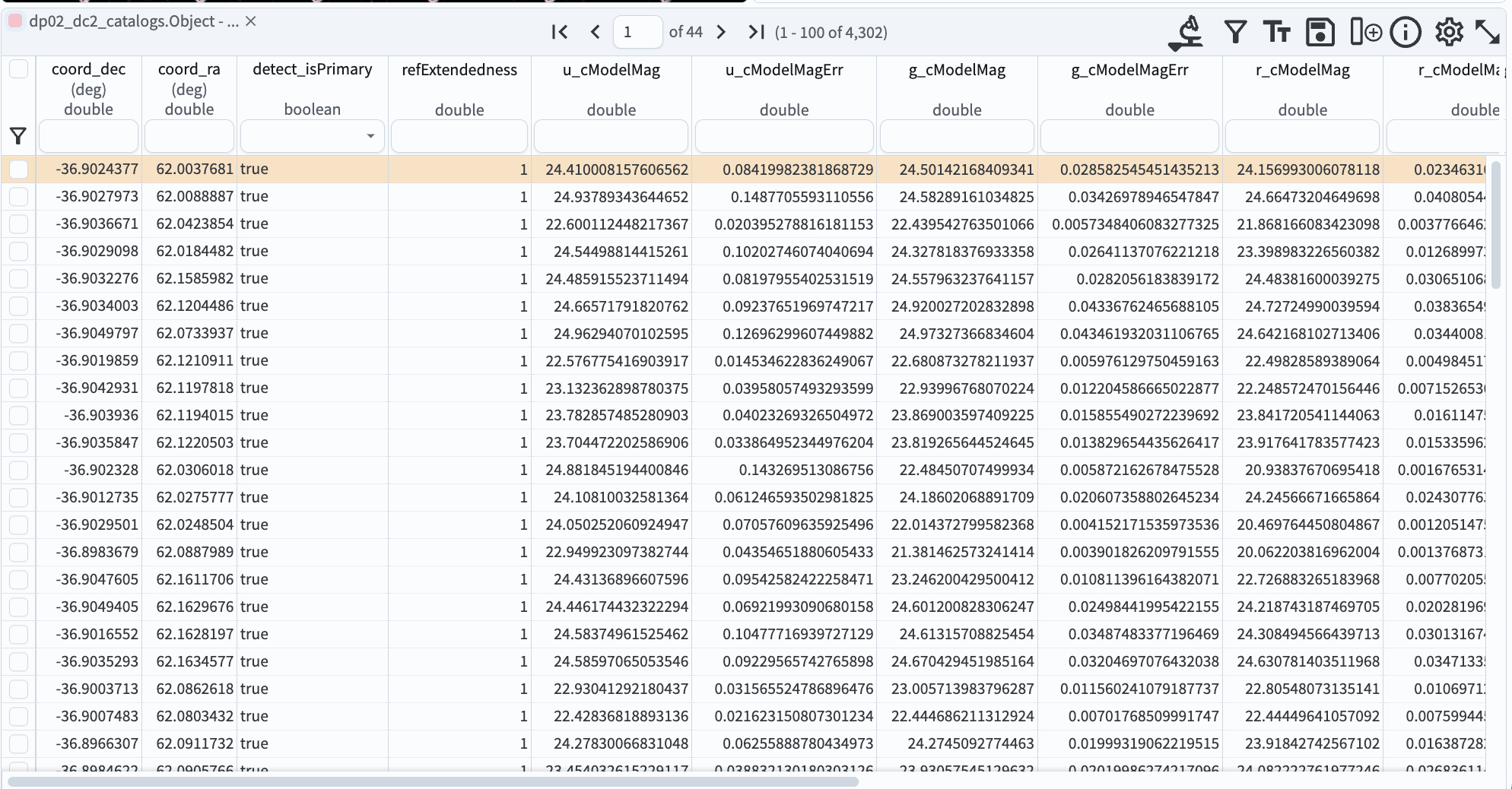05. How to convert fluxes to magnitudes with ADQL¶
RSP Aspect: Portal
Contact authors: Greg Madejski and Melissa Graham
Last verified to run: 2025-02-04
Targeted learning level: beginner
Introduction: This tutorial demonstrates how to convert fluxes to magnitudes using a special ADQL function.
Warning! Fluxes measured in difference images can be negative. Negative fluxes should not be converted to magnitudes using this special ADQL function.
1. Go to the DP0.2 catalog ADQL interface. Navigate to the Portal’s DP0.2 Catalogs tab and switch to the ADQL interface.
2. To return magnitudes use the scisql_nanojanskyToAbMag() function.
This function will convert a flux value with the units of nanoJanskies (nJy) into an AB magnitude.
The conversion is \(m = -2.5 log(f) + 31.4\), where \(m\) is magnitude and \(f\) is flux.
SELECT coord_dec, coord_ra, detect_isPrimary, refExtendedness,
scisql_nanojanskyToAbMag(u_cModelFlux) AS u_cModelMag,
scisql_nanojanskyToAbMag(g_cModelFlux) AS g_cModelMag,
scisql_nanojanskyToAbMag(r_cModelFlux) AS r_cModelMag,
scisql_nanojanskyToAbMag(i_cModelFlux) AS i_cModelMag,
scisql_nanojanskyToAbMag(z_cModelFlux) AS z_cModelMag,
scisql_nanojanskyToAbMag(y_cModelFlux) AS y_cModelMag
FROM dp02_dc2_catalogs.Object
WHERE CONTAINS(POINT('ICRS', coord_ra, coord_dec),
CIRCLE('ICRS', 62, -37, 0.167)) =1
AND (detect_isPrimary =1 AND refExtendedness =1
AND u_cModelFlux >360 AND g_cModelFlux >360
AND r_cModelFlux >360 AND i_cModelFlux >360
AND z_cModelFlux >360 AND y_cModelFlux >360)
3. To return magnitude errors use the scisql_nanojanskyToAbMagSigma() function.
This funtion will convert the corresponding flux errors, in nJy, into AB magnitude errors.
SELECT coord_dec, coord_ra, detect_isPrimary, refExtendedness,
scisql_nanojanskyToAbMag(u_cModelFlux) AS u_cModelMag,
scisql_nanojanskyToAbMagSigma(u_cModelFlux, u_cModelFluxErr) AS u_cModelMagErr,
scisql_nanojanskyToAbMag(g_cModelFlux) AS g_cModelMag,
scisql_nanojanskyToAbMagSigma(g_cModelFlux, g_cModelFluxErr) AS g_cModelMagErr,
scisql_nanojanskyToAbMag(r_cModelFlux) AS r_cModelMag,
scisql_nanojanskyToAbMagSigma(r_cModelFlux, r_cModelFluxErr) AS r_cModelMagErr,
scisql_nanojanskyToAbMag(i_cModelFlux) AS i_cModelMag,
scisql_nanojanskyToAbMagSigma(i_cModelFlux, i_cModelFluxErr) AS i_cModelMagErr,
scisql_nanojanskyToAbMag(z_cModelFlux) AS z_cModelMag,
scisql_nanojanskyToAbMagSigma(z_cModelFlux, z_cModelFluxErr) AS z_cModelMagErr,
scisql_nanojanskyToAbMag(y_cModelFlux) AS y_cModelMag,
scisql_nanojanskyToAbMagSigma(y_cModelFlux, y_cModelFluxErr) AS y_cModelMagErr
FROM dp02_dc2_catalogs.Object
WHERE CONTAINS(POINT('ICRS', coord_ra, coord_dec),
CIRCLE('ICRS', 62, -37, 0.167)) =1
AND (detect_isPrimary =1 AND refExtendedness =1
AND u_cModelFlux >360 AND g_cModelFlux >360
AND r_cModelFlux >360 AND i_cModelFlux >360
AND z_cModelFlux >360 AND y_cModelFlux >360)
4. Notice the query constraints on coordinate, extendedness, flux, and the detect_isPrimary flag are set in order to
retrieve a small sample of point-like objects (stars) brighter than 25th magnitude (as in preceding tutorials).
5. View the results.
Figure 1 shows the table panel in the Results tab for the query above.
Notice that there are no flux columns because they were retrieved AS magnitudes,
and the columns have been renamed as specified in the ADQL statement.

Figure 1: The table panel in the Results tab for the query above shows no flux columns, but magnitude and magnitude error columns.¶
Note. For a demonstration of how to convert fluxes to magnitudes after a query is executed, see the tutorial on how to use the results table data.
Return to the list of DP0.2 Portal tutorials.